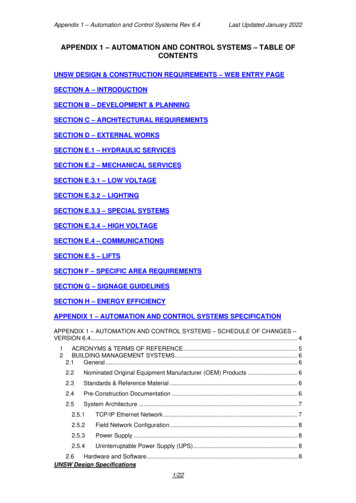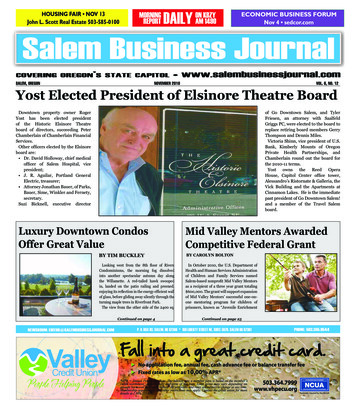
Transcription
Appendix 9Salem Climate Action PlanCITY COUNCIL WORK SESSIONPatricia Farrell, Climate Action Plan ManagerKim Morrow, Director of Climate Planning and Resilience, Verdis GroupSeptember 20, 2021
Appendix 9Project Context
Appendix 9What's atstake?The changing climate impacts us in the form of: Floods Drought More extreme heat days (above 90 F) Wildfires Hazardous air quality from wildfires Extreme winter eventsImpacts of climate change are not experienced equally“Human influence has warmed the climate at a rate that is unprecedented in atleast the last 2000 years.” - Intergovernmental Panel on Climate Change, 2021.
Appendix 950%Reduce Salem’s greenhouse gasemissions by 50% by 20350%Become carbon neutral city by 2050CLIMATE ACTION PLAN GOALSIn October 2020, City Council adoptedthe following goals as part of the Salem’sClimate Action Plan:1.2.By 2035, Salem’s greenhouse gasemissions shall be reduced to 50% ofthe citywide greenhouse gasemissions from the baseline year of2016, andBy 2050, Salem should be carbonneutral.4
Appendix 9WHAT IS SALEM’SCLIMATE ACTION PLAN?A plan to: Achieve Climate Action Plan Goalsfor reducing greenhouse gasemissions (mitigation) Help the Salem communityprepare for climate change(adaptation / resiliency) Identify and recommend actions toprioritize for implementation Identify key partners forimplementation5
Appendix 9Where are we in velopmentImplementationPlanning &StrategyRefinementFall 2020Winter 2021Winter-Spring 2021Summer-Fall 2021Fall 2021Task ForceWorkshop #1Nov. 18, 2020Task ForceWorkshop #2Jan. 13, 2021Task ForceWorkshop #3March 3, 2021Task ForceWorkshop #5June 23, 2021Boards &CommissionsTask ForceWorkshop #4April 7, 2021City Council WorkSessionSeptember 20, 2021Task ForceWorkshop #6Oct. 27, 2021Finalization ofPlanCity CouncilPublic HearingDec. 6, 20216
Appendix 9Public Engagement
Appendix 9Climate Action PlanTask ForceRepresentatives from transportation,commercial, residential, environmentaladvocacy, economic development, energy,education, communities of color, food supply,public health, homebuilders, and others 33 community representatives 3 City councilors (Andersen, Gonzalez, &Nordyke) Plus 5 City staffSee Attachment 2 of Staff Report for a completelistof thestrategies 1 in Staff Report for full list of Task Force members.SeeAttachment8
Appendix 9Community ParticipationThe following is a list of communityparticipation/ opportunities: Initial community survey Envisioning a resilient Salem activity Strategy ideas brainstorming activity Strategy ideas ranking survey Strategy development feedback activity Surveys, focus groups, and meetings withtargeted communities Review draft Climate Action PlanSalemClimateActionPlan.com/Get-Involved9
Appendix 9Project OutreachThe following is a list of outreach strategies: Community presentations and forums (32) Presentations to City Boards and Commissions (6) Attending community events (6) Radio interviews (3) Weekly public services announcements over radio Weekly social media posts Salem Connection, City’s weekly e-newsletter Distributing project handouts and surveys (Englishand Spanish) at community events Documenting and posting of all meetingmaterials, meeting recordings, and pertinentstudies on project website10
Appendix 9Salem’s GHG Emissions Sources
Appendix 9Where do Salem’sEmissions ComeFrom?2016 SECTOR-BASEDGREENHOUSE GASINVENTORY Largest source of emissions istransportation Second-largest is electricitygeneration Third-largest is stationarycombustion, i.e., natural gas usageTotal:1.5M MtCO2e
Appendix 9Increasing Resilience, Reducing Emissions, andBuilding Equity
Appendix 9ACTION AREASThe strategies in the Climate Action Plan areorganized around the following Action Areas:1.2.3.4.5.6.7.Transportation & Land UseEnergyEconomic DevelopmentNatural ResourcesCommunityFood SystemMaterials & WasteSee Attachment 2 of Staff Report for acomplete list of the strategies.
Appendix 9Greenhouse Gas Emissions Forecasts
Appendix 9SCENARIO 1
Appendix 9What is required to achieve Scenario 1?1.2.3.4.5.6.7.8.9.10.Double the rate of electric vehicle (EV)adoptionQuadruple the rate of transit ridershipDouble the rate at which residents usebiking and walkingTransition to a zero-emissions bus fleetReduce the amount of passenger vehicletraffic coming into and out of Salem by40%Reduce the amount of traffic within Salemby 10%Halt all growth in natural gas emissionsImprove building efficiency by an averageof 10% by 2050Maximize onsite solarMaximize carbon sequestration of plantsand trees
Appendix 9SCENARIO 1RESULTS 40% net reductionin emissionsby 2035 58% net reductionin emissionsby 2050
Appendix 9Why wasn’t the target met?BREAKDOWN OF REMAININGGHG EMISSIONS IN 2050Several types of emissions will be challenging toeliminate. Transportation emissions from internalcombustion engines will constitute nearly halfof remaining emissions Natural gas emissions will constitute nearlyone-third Wastewater will constitute 19%
Appendix 9SCENARIO 2
Appendix 9Whatis required to achieve Scenario 2?11.12.13.14.15.16.17.18.19.Halt the entry of non-resident internalcombustion engine trafficHalt the entry of internal combustionengine heavy truckingHalt internal combustion air trafficEnsure a 100% renewables-only electricitygridRemove all fossil fuel-derived natural gassystems in the built environmentRemove all other building fossil fuels (e.g.propane, diesel) in the built environmentAchieve zero waste through circulareconomy, compost, recyclingCapture all wastewater emissionsHalt all septic emissions by requiringlocations on septic to join centralizedwastewater treatment
Appendix 9AssumptionsModeled in Scenario 21.2.3.4.5.6.7.8.9.10.Double the rate of electric vehicle (EV)adoptionQuadruple the rate of bus ridershipDouble the rate at which residents usebiking and walkingTransition to a zero-emissions bus fleetReduce the amount of passenger vehicletraffic coming into and out of Salem by40%Reduce the amount of traffic within Salemby 10%Halt all growth in natural gas emissionsImprove building efficiency by an averageof 10% by 2050Maximize onsite solarMaximize carbon sequestration of plantsand trees11.12.13.14.15.16.17.18.19.Halt the entry of non-resident internalcombustion engine trafficHalt the entry of internal combustionengine heavy truckingHalt internal combustion air trafficEnsure a 100% renewables-only electricitygridRemove all fossil fuel-derived natural gassystems in the built environmentRemove all other building fossil fuels (e.g.propane, diesel) in the built environmentAchieve zero waste through circulareconomy, compost, recyclingCapture all wastewater emissionsHalt all septic emissions by requiringlocations on septic to join centralizedwastewater treatment
Appendix 9SCENARIO 2RESULTS 57% reduction inemissions by2035 Net zeroemissions by2050
Appendix 9What about purchasing carbon offsets?CARBON OFFSETS ARE ACTIONS TAKEN TO COMPENSATE FOR THEEMISSION OF GHGsNeither scenario includes carbon offsets The cost of carbon offsets currently ranges from about 6 - 15 per MtCO2e Scenario 1 shows close to 600,000 MtCO2e remaining in 2050 It would cost the City 3.9M - 9.7M per year to offset that amount
Appendix 9Keys to Implementation
Appendix 9KEYS TO IMPLEMENTATIONThe following strategies will be needed toensure the success of the Climate Action Plan:1.Hire an FTE coordinator to leadimplementation and provide funding forthe person and program2.Establish a working group to guidecommunity-wide implementation3.Prioritize equity4.Regularly communicate with Salemresidents, businesses, and others5.Track and report emissions at regularintervals6.Update the Climate Action Plan every fiveyears
Appendix 9High-Impact GHG Reduction Strategies
Appendix 9High-Impact GHG Reduction StrategiesENERGYThe following strategies could have a high impact in reducing emissions. Create energy benchmarking and transparency policies and reward building owners who improvebuilding energy efficiency. Develop a comprehensive program to help residents and business owners weatherize buildings andimprove energy efficiency, with a priority emphasis on properties with low-income renters. Provide incentives for new construction that is all-electric. Implement an incentive program for residents and businesses to switch from natural gas appliancesto all-electric models. Implement policies to reduce natural gas usage, such as requiring all-electric new construction,prohibiting fossil fuel usage in new construction, and/or banning the use of gas and oil in residentialappliances.
Appendix 9High-Impact GHG Reduction StrategiesTRANSPORTATIONThe following strategies could have a high impact in reducing emissions. Expand public transit infrastructure in Salem with a focus on equity-based access. Increase urban density along the core transportation network. Incentivize Salem area employees to shift from driving alone to using alternative formsof transportation, including carpooling, walking, biking, and transit. Where possible,increase work from home options. Charge for city-controlled parking using a model intended to reduce parking in thecentral business district to 70-80% of supply.
Appendix 9Where are we in velopmentImplementationPlanning &StrategyRefinementFall 2020Winter 2021Winter-Spring 2021Summer-Fall 2021Fall 2021Task ForceWorkshop #1Nov. 18, 2020Task ForceWorkshop #2Jan. 13, 2021Task ForceWorkshop #3March 3, 2021Task ForceWorkshop #5June 23, 2021Boards &CommissionsTask ForceWorkshop #4April 7, 2021City Council WorkSessionSeptember 20, 2021Task ForceWorkshop #6Oct. 27, 2021Finalization ofPlanCity CouncilPublic HearingDec. 6, 202130
Appendix 9Council Discussion
Appendix 9in partnership with
Appendix 9CITY OF SALEM555 Liberty St SESalem, OR 97301Staff ReportFile #: 21-323Version: 1Date: 9/20/2021Item #: 2.a.TO:Mayor and City CouncilTHROUGH:Steve Powers, City ManagerFROM:Peter Fernandez, PE Public Works DirectorSUBJECT:Salem Climate Action Plan Work SessionWard(s): All WardsCouncilor(s): All CouncilorsNeighborhood(s): All NeighborhoodsService Area(s): Safe Community; Welcoming and Livable Neighborhood; Good Governance; NaturalEnvironment StewardshipSUMMARY:A City Council work session on the Salem Climate Action Plan is scheduled for September 20. Toassist City Council in advance of the work session, this report summarzes the project approach,progress to date, and implementation strategies to meet the City’s Greenhouse Gas reduction goals.ISSUE:Salem Climate Action Pla.RECOMMENDATION:Information only.FACTS AND FINDINGS:Salem began developing its Climate Action Plan (CAP) in August 2020. In October 2020 Councilestablished two goals:1. Reduce Salem’s Greenhouse Gas (GHG) emissions 50% from 2016 levels by 2035; andCITY OF SALEMPage 1 of 3Printed on 9/22/2021powered by Legistar
Appendix 9File #: 21-323Version: 1Date: 9/20/2021Item #: 2.a.2. Be carbon neutral by 2050.Verdis Group, a consulting firm specializing in climate action planning, was hired to assist indeveloping the CAP. A 33-member Task Force was established with a broad cross-communityrepresentation (Attachment 1). The Task Force has conducted five workshops that focused on vision,vulnerability, GHG forecast modeling, strategy development, and strategy priorities. The public hasbeen engaged and informed throughout the process via online activities, public presentations,community events, radio interviews, public service announcements, and social media posts.Information was provided in both English and Spanish.Salem is vulnerable to climate change impacts, including flooding, drought, excessive heat days(days with temperatures over 90 degrees Fahrenheit), and wildfires in the region. These impacts cancascade, disrupting transportation, agricultural production, food supplies, and public health.People of color, residents living in poverty, seniors, children, and people who work or live outdoorsare impacted disproportionately by extreme weather. The CAP includes guiding equity principles toassist with implementation across the community.To reach the goals set by Council, the Task Force, consultants, and residents of our communityworked together to develop a variety of strategies for both GHG reduction and community resilience.Over 170 strategies in seven different action categories have been proposed (Attachment 2). Actionareas include transportation/land use, energy, natural resources, economic development, materialsand waste, food, and community/equity. The drafted strategies are still open for refinement and newstrategies may be added. Each strategy is qualitatively assessed for GHG reduction potential, cost,lead agency, co-benefits, and timeframe for implementation.A detailed, triple bottom line (social, environmental, financial) benefit-cost analysis was undertakenfor ten strategies that have the City as the lead implementation agency and have high GHG reductionimpacts. These ten strategies were selected by the three Councilors serving on the Task Force. Theanalysis showed that three of the 10 strategies had a positive benefit-cost ratio. These strategieswere increasing parking fees, improving building weatherization, and expanding the urban treecanopy (Attachment 3). The benefit-cost ratios of the other selected strategies were more nuanceddue to variables such as rates of adoption by Salem residents.The next step in developing Salem’s CAP is to prioritize the strategies based on their impacts onreducing GHG emissions; the City’s ability to undertake the actions as a municipal government; andthe ability to fund and staff the actions. Many of the strategies rely on partnerships with otherorganizations, such as Cherriots, Portland General Electric, and Energy Trust of Oregon.Implementing Salem’s CAP has a long timeframe; therefore, it will be essential to actively monitorprogress towards the goals. The CAP should be considered a roadmap toward a desired future. Thisroadmap will need to be updated and amended to address emerging technologies, as well aschanging state and federal regulations and initiatives. Priorities for implementation may shift overtime and the CAP should be adjusted to stay current and maintain progress.CITY OF SALEMPage 2 of 3Printed on 9/22/2021powered by Legistar
Appendix 9File #: 21-323Version: 1Date: 9/20/2021Item #: 2.a.Reducing GHG emissions will require many actions by the City, businesses, nonprofits, partnerorganizations, and residents. Based on recent GHG forecast modeling it will be difficult for the City toreach the 2035 and 2050 goals without making significant changes in regulations, policies, practices,and behavior.BACKGROUND:Work on the Salem CAP began in August 2020. To date, five Task Force workshops have been held,and a final, sixth workshop is planned for October 27. In October, the Task Force meeting will focuson plan implementation.All Task Force meetings are recorded and materials from the meetings are posted on the projectwebsite under the heading “project resources” at: es .Work on the Salem CAP is being closely coordinated with the Our Salem Comprehensive Plan update.Both plans will influence development and transportation patterns in the City, and both have theability to reduce GHG emissions.The goal is to present the final draft Climate Action Plan to Council on December 6 for approval.Robert D. Chandler PhD, PEAssistant Public Works DirectorAttachments:1. Salem Climate Action Plan Task Force Members2. Proposed Strategies for Salem Climate Action Plan v.163. Benefit-Cost Analyses for Ten Climate Action Plan StrategiesCITY OF SALEMPage 3 of 3Printed on 9/22/2021powered by Legistar
Task Force Workshop #1 Nov. 18, 2020 Fall 2020 Winter 2021 Task Force Workshop #2 Jan. 13, 2021 Summer-Fall 2021 Task Force Workshop #3 March 3, 2021 Task Force Workshop #4 April 7, 2021 Winter-Spring 2021 Task Force Workshop #5 June 23, 2021 City Council Work Session September 20, 2021 Task Force Workshop #6 Oct. 27, 2021 Fall 2021 6 Boards .











